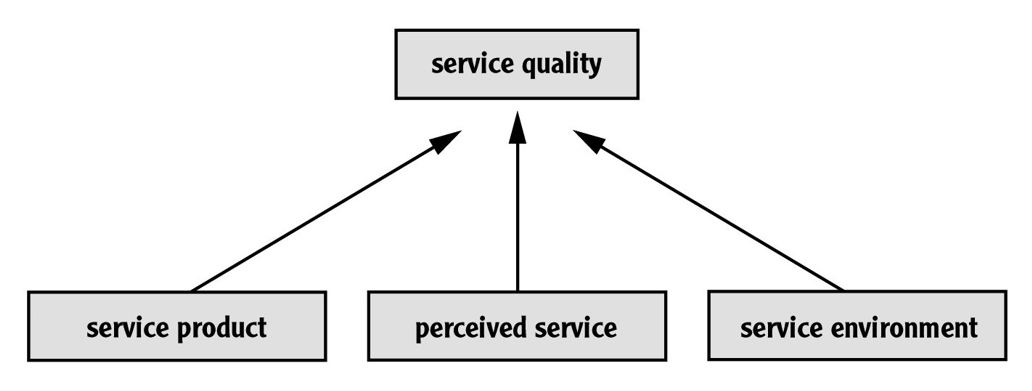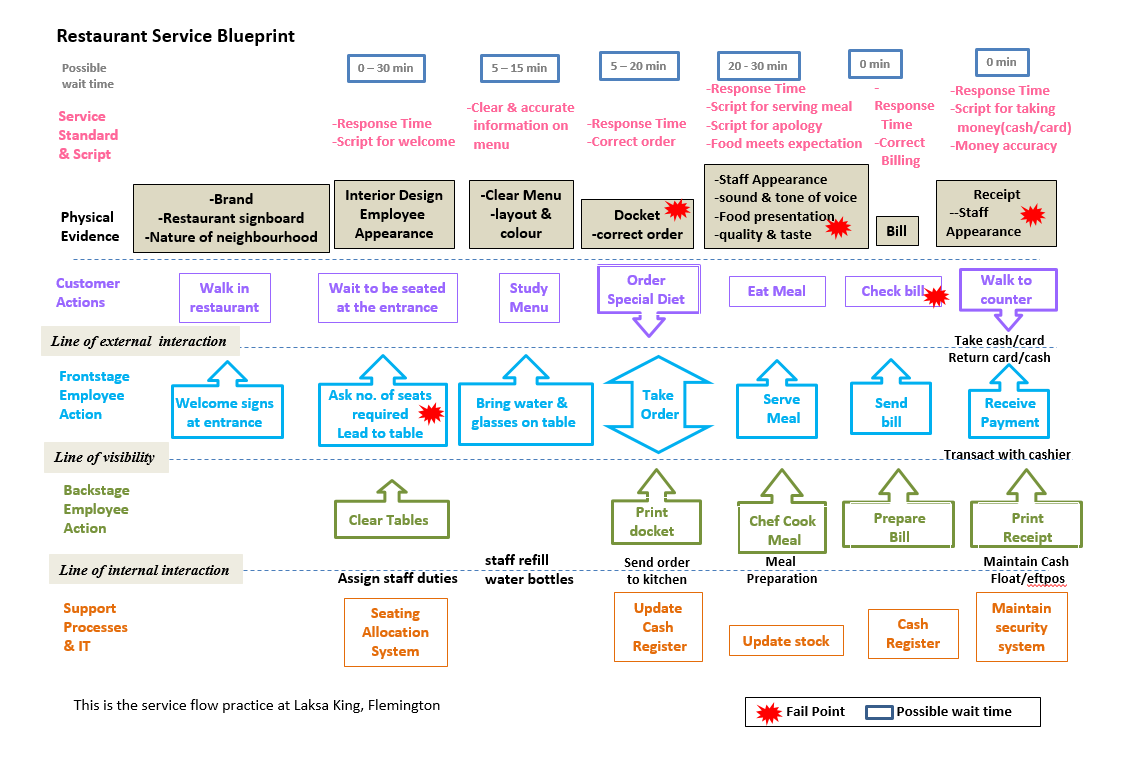Executive Summary
It is important to note that any process of service delivery is bound to have weak points within the link chain of procedures. Identification of these inefficiencies is the key to ensuring the continuously improving the entire service delivery. Laksa King should use the three-component model of physical service, perceived service, and service environment. Bottlenecks need to be assessed serially with an emphasis on physical constraints. Feedback systems need to be implemented in the docketing, food presentation, and billing processes. Staff appearance aspects need to be controlled and monitored by the manager only. The most critical fail point is the table lead stage, which needs to be addressed prior to any other process since it is the major bottleneck of the procedural flow. The service environment needs to be accommodating and available to customers, without which other processes might not need adjustments. If there is an excessive demand problem, raising prices might ensure revenue, reduce demand, and possibly eliminate all other bottlenecks as well.
Introduction
The focus on the given case analysis will be Laksa King, Flemington, a Malaysian restaurant with unique cuisine. The key recommendations are centered around total quality management improvement primarily through true quality service on the basis of the three-component model of physical service, perceived service, and service environment.
Service Blueprint: Key Parts and Stages
What is the Service Blueprint?
In order to ensure that the restaurant is able to improve its service design, the service blueprint is essential. The latter can be defined as “a diagram that visualizes the relationships between different service components — people, props (physical or digital evidence), and processes — that are directly tied to touchpoints in a specific customer journey” (Gibbons, 2017, para. 2). The service process blueprint can be accessed in Figure 1 of the Annexure. The figure contains important details on the core parts and stages with their respective wait times.
Discussion of the Service Consumed
Each phase of the service bundle is delivered on several layers, such as physical evidence, customer actions, frontstage and backstage employee actions, and support process and IT. The series of parts begins with brand and restaurant recognition in its environment, which is followed by interior design and staff appearance. The subsequent service bundle stage is the menu presentation and order, and the latter elements are followed by the core of the process, which is the meal itself. The final stages revolve around billing and money transfer processes.
Challenges
The main challenges of Laksa King restaurant are fail points at five distinct stages spread across three layers. These include asking for the number of seats required and leading to the table, correct ordering, food presentation and its quality, bill checking, and staff appearance during money transfer. The problems are mostly inefficiencies and lag times within these procedures, which act as a bottleneck for the flow of service delivery processes. It is stated that “blueprints are treasure maps that help businesses discover weaknesses. Poor user experiences are often due to an internal organizational shortcoming — a weak link in the ecosystem” (Gibbons, 2017, para. 7). They are the primary culprit for worsened customer experience, which needs to be smooth and be equivalent to or exceed the customer expectations.
Complexities
The issue is made complex by the multifaceted nature of the challenges since they are present in a multitude of layers across the service blueprint. The foundational core layer is the line of internal interactions supported by IT and relevant processes, such as seating allocation system, update mechanisms, cash register, and security systems. The given layer dictates the backstage employee actions, which include clearing tables, printing dockets, meal cooking by chefs, bill preparation, and printing of receipts. Frontstage employees act as intermediaries between the latter layers and customers, whose interactions manifest in customer experience accompanied by physical evidence.
Recommendations
Service Delivery in Business Sustainability
The basis of the recommendations is rooted in the three-component model of service quality shown in Figure 2 below. The three major components include service environment, perceived service, and service product (Khader & Madhavi, 2017). It is stated that “the overall perception of service quality is based on the customer’s evaluation of three dimensions of the service encounter: (1) the customer-employee interaction, (2) the service environment, and (3) the outcome” (Khader & Madhavi, 2017, p. 22). In other words, customer experience is shaped by three influences observed within the service delivery bundle, which are reflective of service quality. A customer enters the service chain and evaluates the general environment in which he or she is placed. Such an individual is also impacted by the staff’s appearance and communication manners, indicating the functional quality. The last evaluative point is rooted in the service itself, which corresponds to technical quality.

Customer Dimension in Business Sustainability
Although the two-dimensional model can be sufficient in many service provision cases, it does not incorporate the critical aspect of the environment. A customer willing to expose himself or herself to foreign cuisines, such as Malaysian food, might not have firm expectations, which means that the two-dimensional model might not be as effective. It is stated that there is “a linkage between service quality, customer satisfaction, and customer loyalty and came out with direct and indirect effects of service quality on customer loyalty through customer satisfaction” (Arora & Narula, 2018, p. 30). The three-component model should be selected due to its inclusion of the environment in the quality and customer experience.
Customer Expectations
In order to ensure the highest level of customer satisfaction, his or her expectations must be met or exceeded. Firstly, it is recommended to apply the three-component model to the service blueprint by allocating each layer to a fail point for every corresponding aspect of the model. Secondly, the failure in the process of asking for the number of seats required and leading to the table should be attributed to the service environment problem. In other words, seats and tables are essential parts of the environment in which the core service of food provision is handled.
Thirdly, docketing and correct order, food presentation, and staff appearance at the final stage should be allocated to the service product aspect of the framework. The main reason is that these elements are part of the physical evidence layer, which are directly related to service products aspects. Fourthly, bill checking by the customers and the fail point within this process is attributable to perceived service since it is performed by the consumer directly without any interruption from the service provider. Enhancing customer expectations can only be done by using employees as customer advocates to act in the best interests of the clients of the restaurant.
Customer Information and Feedback
When it comes to customer information and feedback elements, the essential data should be collected within the process of service delivery process or service bundle. The provided feedback is critical to assessing the overall customer satisfaction levels. It is stated: “studies that link satisfaction with performance have found that consumer satisfaction is strongly related to marketing performance, explaining more than seventy percent of the variation” (Macieira et al., 2020, p. 350). Among all five failure points, only two processes might face the difficulty of implementing some form of feedback collection method into the staff’s script of action.
While a waiter dockets the order, he or she can easily collect feedback data on the correctness of the list by restating all foods and drinks to customers. In the case of food presentation and quality with taste, a waiter can ask politely about the enjoyment level of the meal by the customers. The latter will provide another feedback data to work with since some foods might be underperforming compared to others. While the bill checking action is performed by customers, a staff member can collect feedback by asking whether the bill is comprehensive and clear for understanding. Sometimes the medium in which a bill is delivered can be the source of the problem.
The feedback collection system is difficult or inappropriate to implement in regard to staff appearance and leading to the table. The latter is a matter of physical constraints, which requires either expansion of the available space or creative solutions with better usage of the existing space. If both options are unavailable or already integrated, then it is a matter of supply and demand, where prices need to be increased to reduce demand, so there is always some available table and seats for coming customers. In the case of the staff appearance, the feedback is inappropriate since it involves judging a person by his or her looks. It is a manager’s responsibility to appoint the best-looking staff members to the key positions in the service delivery chain.
Evaluation of Requirements
The evaluation of the effectiveness of the proposed changes needs to be evaluated sequentially rather than simultaneously. The first and most critical fail point is the table lead stage, which needs to be addressed prior to any other process since it is the major bottleneck of the procedural flow. The service environment needs to be accommodating and available to customers, without which other processes might not need adjustments. If there is an excessive demand problem, raising prices might ensure revenue, reduce demand, and possibly eliminate all other bottlenecks as well.
The remaining evaluations of requirements need to be conducted after the changes are incorporated with effective feedback mechanisms. An increase in the overall positive to negative feedback ratio can provide information on whether or not a change was effective. Lastly, the staff appearance and money transfer stage need to be controlled and evaluated by the manager through a deliberate observation of customer-employee interactions.
Conclusion
In conclusion, Laksa King should use the three-component model of physical service, perceived service, and service environment. Bottlenecks need to be assessed serially with an emphasis on physical constraints. Feedback systems need to be implemented in the docketing, food presentation, and billing processes. Staff appearance aspects need to be controlled and monitored by the manager only.
References
Arora, P., & Narula, S. (2018). Linkages between service quality, customer satisfaction and customer loyalty: A literature review. IUP Journal of Marketing Management, 17(4), 30–53. Web.
Gibbons, S. (2017). Service blueprints: Definition. Nielson Normal Group. Web.
Khader, D. A., & Madhavi, C. (2017). Progression of service quality concepts. Global Journal of Management and Business Research: Administration and Management, 17(6), 17-27. Web.
Macieira, F., Oliveira, T., & Yanaze, M. (2020). Models of satisfaction antecedents: A brief review. An integrative literature review of the most discussed satisfaction models in marketing studies. International Journal of Services and Operations Management, 36(3), 348. Web.
Annexure
